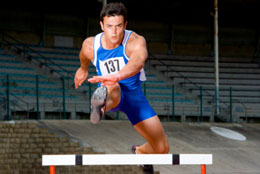Men are more susceptible to a groin muscle injury. To know about the symptoms and treatment of a pulled groin muscle in men, take a look at this article.

Pulled groin muscle is a muscle injury, like any other pulled muscle, of the inner thigh. There are 6 muscles in the inner thigh that are called adductor muscles. These muscles span from the inner pelvis to the thigh bone and help in keeping the legs together while walking, running, swimming, and similar such activities. Athletes and hockey and soccer players are highly prone to this muscle cramp or pull because of the long strides and abrupt stopping and sprinting that their profession demands.
Causes
The causes of sore muscles are similar in men and women. It can be due to a blow in the inner thigh area or twisting, pulling, or overexertion of the tendons (muscle fibers that hold the bones and muscles together and help in facilitating movements). Build up of lactic acid and dehydration in the muscles when not oxygenated is what causes muscle spasms.
Symptoms
The symptoms in men and women are the same and include: muscle pain, difficulty in walking, pain at night, and pain while resting. One of the other main symptoms is change in the color of the skin around the inner thigh region. So, get yourself treated properly upon observing these symptoms. The severity of the pain will decide the appropriate intervention method.
Depending on the degree of groin pain, it can be put under the following 3 categories. This will help you in deciding the right treatment option.
☛ Grade I (Mild)
In this, there is no disability of any sort; however, the groin strain does cause a mild discomfort. It does not limit any physical activity, and the recovery time is about 2 weeks.
☛ Grade II (Moderate)
High-intensity aerobic activities, like jumping, running, etc., cannot be performed, and the discomfort level is moderate. It may be associated with indicants, like moderate swelling and visible bruises in the area and sharp and deep muscle pain at particular angles and postures.
☛ Grade III (Severe)
Due to blood vessel hemorrhage, one can observe increased swelling, bruising, and excruciating pain in the area. The person cannot perform any sort of movement.
Treatment
The treatment options include: ice therapy, heat therapy, RICE therapy, and milder forms of stretches suiting the comfort level of the person with sore muscles. However, the first and foremost thing to be taken care of is to restrict and avoid any strenuous activity.
Muscles are a very important part of our body. They need to be worked upon regularly, as stretching and exercising keep them in a good and firm shape and also help in providing strength. Muscles enable us to perform all kinds of movement activities. Even one of the most important body organs, the heart, is a set of muscles. Lack of exercise and inactivity results in poor muscle strength and saggy muscles. On the contrary, if you overwork your body, you will end up straining the muscles. So, it is very essential to maintain a right balance to avoid injuries, like pulled muscles, etc. Take good care of yourself!
Disclaimer: This Buzzle article is for informative purposes only and should not be used as a replacement for expert medical advice.


 Pulled groin muscle is a muscle injury, like any other pulled muscle, of the inner thigh. There are 6 muscles in the inner thigh that are called adductor muscles. These muscles span from the inner pelvis to the thigh bone and help in keeping the legs together while walking, running, swimming, and similar such activities. Athletes and hockey and soccer players are highly prone to this muscle cramp or pull because of the long strides and abrupt stopping and sprinting that their profession demands.
Pulled groin muscle is a muscle injury, like any other pulled muscle, of the inner thigh. There are 6 muscles in the inner thigh that are called adductor muscles. These muscles span from the inner pelvis to the thigh bone and help in keeping the legs together while walking, running, swimming, and similar such activities. Athletes and hockey and soccer players are highly prone to this muscle cramp or pull because of the long strides and abrupt stopping and sprinting that their profession demands.